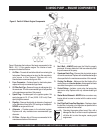
MAYCO C-30HDG PUMP — OPERATION AND PARTS MANUAL — REV. #6 (04/02/12) — PAGE 31
6. If a blockage occurs in a hose, “walk the hose” until you find
the point of trouble. The hose will be soft immediately past the
blockage. If this happens at the start, disconnect the hose at
the first coupling past the blockage.
Elevate the hose at that point with the blockage area hanging
down.
C-30HDG PUMP — OPERATING INFORMATION
A. STOP the pump. Switch OFF the engine.
B. DO NOT open any of the delivery system joint clamps.
C. The
senior
operator must warn all others to stand at
least 20 feet away from the pump and turn their heads
away from the manifold.
D. The operator must position himself/herself away from
the hinged side of the manifold.
E. Wearing safety glasses, grasp the clamp arm weldment
and carefully pull it open to the primary (safety) position.
STOP count to 20. This will allow the pressure to release.
F. After the pressure has been released, open the clamp
arm weldment and swing the hinged discharge cone
open.
G. Remove blockage with a round 2-foot length of reinforc-
ing steel rod. Flush the manifolds with water. Make sure
the (3” x 2”) reducer is clear of any blockage before
closing the discharge cone.
H. After the blockage has been cleared and the pump
manifold has been thoroughly flushed with water, close
the hinged discharged cone and lock into place.
I. Before reconnecting hose to the reducer, start the engine
and pump two or three shovels of concrete through the
reducer. This will insure that all the blockage has been
cleared.
J. Shake out around 2 feet of concrete before reconnecting
hose to pump. After this is done, connect hose to pump
and resume the pumping operation.
8. Avoiding Setting of the Mix in the System
To avoid setting of the concrete mix in the system when
waiting more than 30 minutes between concrete loads, flush
the system depending on job factors (such as presence of
accelerators and job site temperature) and your particular
mix design.
When disconnecting hoses, use
EXTREME CAUTION!
The
hose is under pressure!
1. Disconnect the hoses from the pump and wash the pump out
immediately. For example: If you had 200 ft. of system out, you
would disconnect each hose.
2. Reconnect the first hose and fill the hopper with water. DO
NOT try to push all the concrete out of all of the hose lines at
one time.
3. Clean it out by pushing water through the first hose off the
pump, then continue progressing through all the hoses, until
all the system is clean.
4. If waiting time is excessive, it would be wise to wash out the
pump and hoses and start over when the new truck arrives.
This can be avoided by being observant to the pump and
system, also taking into consideration the above factors
affecting the mix.
Due to pressure build-up inside the manifold, great care must
be taken when clearing a plugged manifold.
DANGER -
Clearing A Plugged Manifold
CAUTION -
Hose Pressure Hazard
Using a hammer, you can pound the down-stream edge of the
packed area until it is free to flow. Shake all of the sand and
gravel out to the end of the hose. Before reconnecting the
hose, start the pump and run a small amount of concrete out
to the end of the hose. This will assure that all of the separation
is out of the hose.
7. Clearing a Plugged Manifold
The manifold is plugged if the volume at the discharge end
of the hose stops, and the hose is soft. The drive belts will start
to slip and the engine will lugdown.
Follow steps 7A through 7J to un-plug a clogged manifold.
When disconnecting hoses, use
extreme
CAUTION!
The hose
is under pressure!
CAUTION -
Hose Pressure Hazard
Clearing a Mix from the System
If, for any reason, the mix should set up in the system, the following
procedure is suggested:


















